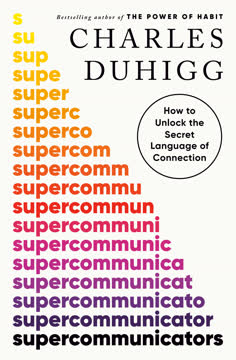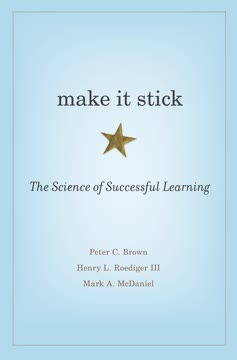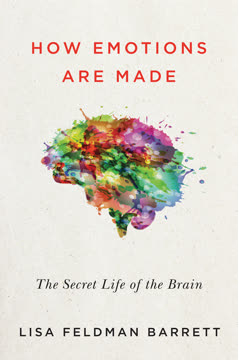نکات کلیدی
1. نقشههای ذهنی: ابزاری انقلابی برای تفکر بصری
نقشه ذهنی یک نمودار پیچیده است که ساختار یک سلول مغزی را با شاخههایی که از مرکز آن به بیرون میروند، بازتاب میدهد و از طریق الگوهای تداعی تکامل مییابد.
نمایش بصری افکار. نقشههای ذهنی نمودارهای رنگارنگ و غیرخطی هستند که ایدهها و اطلاعات را نمایش میدهند. آنها با یک مفهوم مرکزی شروع میشوند و با شاخهها و زیرشاخهها به بیرون گسترش مییابند، با استفاده از کلمات کلیدی، تصاویر و رنگها برای ثبت و سازماندهی افکار.
درگیر کردن هر دو نیمکره مغز. برخلاف روشهای سنتی یادداشتبرداری، نقشههای ذهنی هر دو سمت منطقی چپ و خلاق راست مغز را فعال میکنند. این رویکرد جامع خلاقیت را افزایش میدهد، حفظ حافظه را بهبود میبخشد و تفکر واضحتری را ترویج میکند.
کاربردهای متنوع. نقشههای ذهنی میتوانند برای:
- طوفان فکری و حل مسئله
- یادداشتبرداری و خلاصهسازی اطلاعات
- برنامهریزی و مدیریت پروژه
- تعیین اهداف و توسعه شخصی
- افزایش خلاقیت و تولید ایدههای جدید
2. علم پشت نقشهبرداری ذهنی: بهرهگیری از قدرت مغز
مغز شما یک غول خفته است و تسلط بر نقشه ذهنی اینجاست تا آن را بیدار کند!
تفکر تابشی. نقشههای ذهنی با بهرهگیری از تمایل طبیعی مغز به تفکر تداعیگر کار میکنند. این فرآیند که تفکر تابشی نامیده میشود، به ایدهها اجازه میدهد آزادانه جریان یابند و به صورت غیرخطی متصل شوند، که شبکههای عصبی مغز را بازتاب میدهد.
تقویت حافظه. ترکیب عناصر بصری، کلمات کلیدی و تداعیها در نقشههای ذهنی اطلاعات را به یادماندنیتر میکند. مطالعات نشان دادهاند که نقشهبرداری ذهنی میتواند یادآوری حافظه را تا 32 درصد نسبت به روشهای سنتی یادداشتبرداری بهبود بخشد.
مزایای شناختی:
- بهبود تمرکز و توجه
- تقویت مهارتهای تحلیلی و تفکر انتقادی
- سازماندهی و ساختاردهی بهتر اطلاعات
- افزایش خلاقیت و توانایی حل مسئله
- یادگیری سریعتر و کارآمدتر
3. قوانین نقشهبرداری ذهنی: راهنماییهای ضروری برای ایجاد مؤثر
پیروی از قوانین به شما آزادی میدهد تا سبک منحصر به فرد خود را توسعه دهید، در حالی که به روحیه اصلی نقشهبرداری ذهنی وفادار میمانید.
اصول کلیدی. قوانین نقشهبرداری ذهنی چارچوبی برای ایجاد نقشههای ذهنی مؤثر و قدرتمند ارائه میدهند. این راهنماییها وضوح، ساختار و حداکثر درگیری شناختی را تضمین میکنند.
عناصر ضروری:
- استفاده از کاغذ سفید و بدون خط در حالت افقی
- شروع با یک تصویر مرکزی رنگارنگ که موضوع اصلی را نشان میدهد
- استفاده از شاخههای منحنی که از مرکز تابش میکنند
- نوشتن تنها یک کلمه کلیدی در هر شاخه
- استفاده از تصاویر و نمادها در سراسر نقشه
- استفاده از رنگ برای دستهبندی و تأکید بر اطلاعات
- ایجاد سلسله مراتب واضح با شاخههای اصلی و فرعی
شخصیسازی. در حالی که این قوانین را دنبال میکنید، افراد تشویق میشوند تا سبک خود را توسعه دهند و هر نقشه ذهنی را به یک بیان منحصر به فرد از افکار و خلاقیت خود تبدیل کنند.
4. کاربردهای عملی: نقشههای ذهنی برای کار، تحصیل و زندگی شخصی
چه در حال ایجاد یک نقشه ذهنی برای کار تحقیقاتی باشید یا برای مدیریت پروژه، به آن به عنوان یک بازی نزدیک شوید، نه به عنوان یک کار، تا نتیجهای خلاقانه و برد-برد حاصل شود!
استفاده حرفهای. در محیط کار، نقشههای ذهنی میتوانند بهرهوری و خلاقیت را متحول کنند:
- برنامهریزی و مدیریت پروژه
- جلسات طوفان فکری و تولید ایده
- یادداشتها و خلاصههای جلسات
- ارائهها و گزارشها
- برنامهریزی استراتژیک و تصمیمگیری
کاربردهای آموزشی. دانشآموزان و معلمان میتوانند از نقشههای ذهنی بهرهمند شوند:
- یادداشتبرداری در طول سخنرانیها
- خلاصهسازی موضوعات پیچیده
- آمادگی و مرور امتحانات
- برنامهریزی و نوشتن مقاله
- سازماندهی تحقیقات
توسعه شخصی. نقشههای ذهنی میتوانند جنبههای مختلف زندگی شخصی را بهبود بخشند:
- تعیین اهداف و برنامهریزی زندگی
- حل مسئله و تصمیمگیری
- بهبود حافظه و یادگیری مهارتهای جدید
- نوشتن خلاقانه و پروژههای هنری
- مدیریت زمان و برنامهریزی روزانه
5. غلبه بر چالشها: رفع مشکلات رایج در نقشهبرداری ذهنی
یک نقشه ذهنی همیشه کار میکند وقتی که به خوبی کار شود.
موانع رایج. حتی نقشهبرداران ذهنی با تجربه ممکن است با چالشهایی روبرو شوند:
- دشواری در شروع یا انتخاب موضوع مرکزی
- احساس غرق شدن در اطلاعات پیچیده
- مبارزه با جنبههای هنری یا ارائه بصری
- پیچیده کردن ساختار نقشه ذهنی
راهحلها و استراتژیها:
- با نقشههای ذهنی ساده شروع کنید و به تدریج پیچیدگی را افزایش دهید
- بر کلمات کلیدی و اطلاعات ضروری تمرکز کنید و از شلوغی پرهیز کنید
- نقص در نقاشیها را بپذیرید؛ شکلهای ساده و نمادهای ساده مؤثر هستند
- به طور منظم تمرین کنید تا سبک شخصی و کارایی خود را توسعه دهید
- نقشههای ذهنی خود را مرور و اصلاح کنید تا وضوح و اثربخشی را بهبود بخشید
تغییر ذهنیت. به نقشهبرداری ذهنی به عنوان یک فرآیند خلاقانه و لذتبخش نزدیک شوید، نه به عنوان یک تکنیک سختگیرانه. به خود اجازه دهید که آزمایش کنید و از هر تلاش یاد بگیرید.
6. تکنیکهای پیشرفته نقشهبرداری ذهنی: ارتقاء مهارتهای شما به سطح بعدی
هرچه بیشتر روی نقشه ذهنی خود کار کنید، بیشتر با شما صحبت خواهد کرد و تمام راهنماییهای مورد نیازتان را ارائه خواهد داد!
حل مسائل پیچیده. از تکنیکهای پیشرفته نقشهبرداری ذهنی برای مقابله با مسائل پیچیده استفاده کنید:
- ایجاد نقشههای ذهنی چندگانه و متصل برای پروژههای بزرگ
- استفاده از سیستمهای کدگذاری رنگی برای سازماندهی عمیقتر
- استفاده از ترتیب عددی برای فرآیندهای متوالی
- استفاده از استعارهها و تشبیهها برای نمایش مفاهیم انتزاعی
نقشهبرداری ذهنی گروهی. در جلسات نقشهبرداری ذهنی گروهی شرکت کنید برای:
- طوفان فکری تیمی و تولید ایده
- حل تعارض و یافتن زمینه مشترک
- برنامهریزی و مدیریت پروژه مشترک
- فرآیندهای تصمیمگیری جمعی
ادغام با ابزارهای دیگر. نقشهبرداری ذهنی را با تکنیکهای مکمل ترکیب کنید:
- تحلیل SWOT برای برنامهریزی استراتژیک
- نمودارهای ایشیکاوا برای تحلیل علت و معلول
- نمودارهای گانت برای زمانبندی پروژه
- نقشههای ذهنی به عنوان پیشزمینهای برای نوشتن گزارشها یا مقالات دقیق
7. آینده نقشهبرداری ذهنی: ابزارهای دیجیتال و تأثیر جهانی
امروزه، مردم در سراسر جهان با مفهوم نقشهبرداری ذهنی آشنا هستند.
تکامل دیجیتال. نقشهبرداری ذهنی پیشرفتهای فناوری را پذیرفته است:
- نرمافزارها و اپلیکیشنهای نقشهبرداری ذهنی دیجیتال
- پلتفرمهای نقشهبرداری ذهنی مبتنی بر ابر
- ادغام با ابزارهای بهرهوری و مدیریت پروژه
- ایجاد و تحلیل نقشه ذهنی با کمک هوش مصنوعی
پذیرش جهانی. نقشهبرداری ذهنی به رسمیت جهانی دست یافته است:
- گنجاندن در برنامههای آموزشی در فرهنگهای مختلف
- پذیرش توسط شرکتهای چندملیتی برای فرآیندهای کسبوکار
- مسابقات و قهرمانیهای نقشهبرداری ذهنی
- کاربردهای بینفرهنگی که به سبکهای تفکر متنوع تطبیق مییابند
تحقیقات مداوم. مطالعات مستمر درباره مزایای شناختی نقشهبرداری ذهنی:
- تحقیقات علوم اعصاب درباره فعالیت مغزی در حین نقشهبرداری ذهنی
- کاربردها در توانبخشی شناختی و سلامت روان
- بررسی پتانسیل نقشهبرداری ذهنی در هوش مصنوعی و یادگیری ماشین
- توسعه تکنیکهای جدید نقشهبرداری ذهنی برای زمینهها و چالشهای نوظهور
آخرین بهروزرسانی::
FAQ
What's "Mind Map Mastery" about?
- Overview: "Mind Map Mastery" by Tony Buzan is a comprehensive guide to understanding and utilizing Mind Maps, a powerful thinking tool designed to enhance creativity, memory, and problem-solving skills.
- Purpose: The book aims to teach readers how to create and use Mind Maps effectively in various aspects of life, from personal development to professional tasks.
- Structure: It includes practical exercises, real-life examples, and stories from master Mind Mappers to illustrate the transformative potential of Mind Mapping.
- Audience: The book is intended for anyone looking to improve their cognitive abilities, whether they are students, professionals, or lifelong learners.
Why should I read "Mind Map Mastery"?
- Cognitive Enhancement: The book offers techniques to improve memory, creativity, and problem-solving skills, which are beneficial in both personal and professional settings.
- Practical Applications: It provides numerous examples of how Mind Maps can be applied to everyday tasks, making it a practical tool for organizing thoughts and projects.
- Community and Support: Reading the book connects you to a global community of Mind Mappers who share their experiences and insights.
- Personal Growth: It encourages self-discovery and personal development by helping you unlock your brain's full potential.
What is a Mind Map according to Tony Buzan?
- Definition: A Mind Map is a visual thinking tool that mirrors the structure of a brain cell, with branches radiating from a central image to represent ideas and associations.
- Components: It includes a central image, thick branches for main themes, and thinner branches for sub-themes, all connected with keywords and images.
- Purpose: Mind Maps are designed to engage both the logical and creative sides of the brain, enhancing memory and creativity.
- Applications: They can be used for note-taking, brainstorming, planning, and problem-solving across various fields.
How do I create a Mind Map as per "Mind Map Mastery"?
- Materials Needed: Start with a large sheet of plain white paper and a selection of colored pens or pencils.
- Central Image: Draw a central image that represents the main subject, using at least three colors to make it visually engaging.
- Branching Out: Create thick branches radiating from the central image, each representing a key theme, and use different colors for each branch.
- Keywords and Images: Place a single keyword or image on each branch to trigger associations and further ideas.
What are the key takeaways of "Mind Map Mastery"?
- Whole-brain Thinking: Mind Maps activate both hemispheres of the brain, enhancing cognitive functions like memory and creativity.
- Versatility: They can be applied to a wide range of activities, from personal goal setting to professional project management.
- Radiant Thinking: The book emphasizes the concept of Radiant Thinking, where ideas radiate from a central point, promoting a non-linear, organic flow of thoughts.
- Mind Mapping Laws: Following the specific Laws of Mind Mapping ensures clarity, creativity, and effectiveness in the maps you create.
What are the Laws of Mind Mapping according to Tony Buzan?
- Blank Paper: Always use a blank sheet of paper in landscape position to allow for free-flowing ideas.
- Central Image: Start with a colorful central image to engage the brain and trigger associations.
- Keywords and Branches: Use single keywords on branches, with each word or image on its own branch to maintain clarity.
- Color and Imagery: Incorporate colors and images throughout the Mind Map to stimulate memory and creativity.
What are the infinite applications of Mind Maps as described in the book?
- Home and Personal Life: Mind Maps can be used for planning events, setting personal goals, and organizing daily activities.
- Work and Professional Use: They are effective for project management, decision-making, and strategic planning.
- Education and Learning: Mind Maps aid in studying, revising, and understanding complex subjects.
- Creativity and Innovation: They foster creative thinking and can be used in artistic and design processes.
How does "Mind Map Mastery" address common misconceptions about Mind Maps?
- Clarification: The book distinguishes Mind Maps from other diagrams like spider diagrams and concept maps, which lack the same structure and effectiveness.
- Misuse: It addresses the issue of Mind Maps being misunderstood or misappropriated by those not fully trained in the technique.
- Laws Importance: Emphasizes the importance of adhering to the Laws of Mind Mapping to ensure the tool's effectiveness.
- Visual Appeal: Highlights the unique visual and cognitive benefits of true Mind Maps compared to other linear or hierarchical diagrams.
What are some advanced Mind Mapping techniques discussed in the book?
- Mini Mind Maps: Use smaller, focused Mind Maps to explore specific aspects of a larger topic without cluttering the main map.
- Chunking and Boundaries: Group related information into chunks and use boundaries to enhance memory and organization.
- 3D Mind Mapping: Envision Mind Maps in three dimensions to better understand spatial relationships and complex ideas.
- Digital Mind Mapping: Utilize software like iMindMap to create, edit, and share Mind Maps digitally, enhancing collaboration and accessibility.
What are the best quotes from "Mind Map Mastery" and what do they mean?
- "Your brain is a sleeping giant, and Mind Map Mastery is here to help wake it up!" This quote emphasizes the untapped potential of the human brain and how Mind Mapping can unlock it.
- "A Mind Map is a mirror of the mind’s inner workings." It highlights how Mind Maps reflect the natural processes of human thought, making them an effective tool for organizing and understanding information.
- "Mind Maps are analytical in the sense that you can use them to solve any problem." This underscores the versatility of Mind Maps in addressing a wide range of challenges and tasks.
- "The Mind Map is a natural evolution of human thinking." It suggests that Mind Maps are an intuitive tool that aligns with the way humans naturally process information.
How does "Mind Map Mastery" relate to digital and AI advancements?
- Digital Evolution: The book discusses the development of digital Mind Mapping tools like iMindMap, which enhance the accessibility and functionality of Mind Maps.
- AI Potential: It explores the possibility of AI mastering Mind Mapping, which would represent a significant advancement in artificial intelligence.
- 3D Mind Mapping: The future of Mind Mapping may include fully three-dimensional digital maps, offering new ways to visualize and interact with information.
- Human Element: Despite technological advancements, the book emphasizes the irreplaceable value of human creativity and intuition in Mind Mapping.
What is the future of Mind Mapping according to Tony Buzan?
- Continued Evolution: Mind Mapping will continue to evolve alongside technological advancements, integrating with digital tools and AI.
- Global Reach: The book envisions a future where Mind Mapping is a universal skill taught to children and adults worldwide.
- AI Integration: There is potential for AI to learn and apply Mind Mapping techniques, pushing the boundaries of artificial intelligence.
- Personal Empowerment: Mind Mapping will remain a powerful tool for personal development, helping individuals unlock their full cognitive potential.
نقد و بررسی
کتاب تسلط بر نقشه ذهنی نظرات متفاوتی دریافت کرده است. بسیاری از افراد از رویکرد نوآورانه آن در سازماندهی اطلاعات و حل مسئله تمجید میکنند و آن را برای کاربردهای مختلف مفید میدانند. با این حال، برخی از کتاب به دلیل تکراری بودن، تبلیغاتی بودن بیش از حد و کمبود عمق انتقاد میکنند. خوانندگان از تصاویر رنگارنگ و مثالهای عملی قدردانی میکنند اما اشاره میکنند که محتوا میتوانست مختصرتر باشد. در حالی که برخی نقشهبرداری ذهنی را تحولآفرین میدانند، دیگران آن را تنها یکی از ابزارهای سازماندهی میبینند. این کتاب به طور کلی برای مبتدیان توصیه میشود اما ممکن است اطلاعات جدید زیادی برای نقشهبرداران ذهنی با تجربه ارائه ندهد.
Similar Books






















